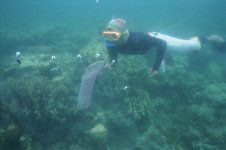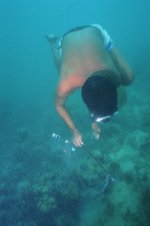G'day John
Good to know I was missed :lol:
I will take that question literally. I think that, on a casual basis, saying that there are fish around is fine. Likewise, a casual reference that there are more inside the MPA than out also works if you are simply stating an opinion based on a short visit. However, as a basis for evaluating sustainability of exploitation, we need good numbers on densities, exploitation levels, and at a minimum, life history characteristics of the targetted species (size at maturity, longevity, mating patterns etc.). In Bohol, I'd also want to know how the species are handling habitat degradation - some will do better (e.g. coral beauties increased in abundance on the Great Barrier Reefs in areas that became overgrown with algae) - some will do worse (all of your obligate corallivores). Exploitation patterns AND scale need to reflect their new reality.
The other issue is the degree to which we hope degraded areas (from exploitation and habitat destruction) can recover. I reckon that, to the degree possible given the need for fishers to earn a living, these areas should be given a break. Frankly, citing a CAMP on a heavily degraded place, and identifying it as a good thing is bizarre. It only works if there are lots of management techniques in place to allow population recovery. And given MAC's focus has been on use of cyanide rather than levels of exploitation, I don't see how this will work.
In terms of "lots of fish" - I feel very fortunate that I dove in the Philippines in the 1980's. What now is "lots", including in Batasan, is a mere shadow of what was. The large degree to which our baselines shift in terms of what is "lots" is, to me, a scary thing. We can keep extracting resources because it's not so bad compared to yesterday and we forgot what it was last year.
MAC obviously needs to invest in a GPS. That would allow you to very easily calculate the size of the collecting areas and manta tows (snorkler holding on to a board dragged behind a banca) could be used simply to assess the proportion of reef / seagrass / rubble / sand habitats within the CAMP.
How does MAC determine whether fish were caught inside or outside the CAMP if the boundaries / size are unclear and how does MAC assess sustainability if it does not know the relative size of CAMP to nonCAMP and Sanctuary to CAMP areas?
Do you know whether MAC placed the CAMP there because the MPA already existed or was that just fortuitous (and could you confirm whether MAC is pitching them as MAC MPAs or recognises the work of the communities to establish them prior to MACs arrival) ? Do you know what plans MAC has to include sanctuaries in other CAMPS and would this be a prerequisite to calling it a CAMP given that the establishment of community-based MPAs can be a lengthy process.
Look forward to your response,
Blue hula
John_Brandt":382mf2o1 said:Blue Hula, I was wondering where you were.
Good to know I was missed :lol:
John_Brandt":382mf2o1 said:I saw good numbers of fish (how does one casually reference fish quantities?) in the collecting area at Batasan.
I will take that question literally. I think that, on a casual basis, saying that there are fish around is fine. Likewise, a casual reference that there are more inside the MPA than out also works if you are simply stating an opinion based on a short visit. However, as a basis for evaluating sustainability of exploitation, we need good numbers on densities, exploitation levels, and at a minimum, life history characteristics of the targetted species (size at maturity, longevity, mating patterns etc.). In Bohol, I'd also want to know how the species are handling habitat degradation - some will do better (e.g. coral beauties increased in abundance on the Great Barrier Reefs in areas that became overgrown with algae) - some will do worse (all of your obligate corallivores). Exploitation patterns AND scale need to reflect their new reality.
The other issue is the degree to which we hope degraded areas (from exploitation and habitat destruction) can recover. I reckon that, to the degree possible given the need for fishers to earn a living, these areas should be given a break. Frankly, citing a CAMP on a heavily degraded place, and identifying it as a good thing is bizarre. It only works if there are lots of management techniques in place to allow population recovery. And given MAC's focus has been on use of cyanide rather than levels of exploitation, I don't see how this will work.
In terms of "lots of fish" - I feel very fortunate that I dove in the Philippines in the 1980's. What now is "lots", including in Batasan, is a mere shadow of what was. The large degree to which our baselines shift in terms of what is "lots" is, to me, a scary thing. We can keep extracting resources because it's not so bad compared to yesterday and we forgot what it was last year.
John_Brandt":382mf2o1 said:Anyway, I don't have figures laying around here on the size of the collecting areas or the MPAs. One gets a relative sense of proportion when you are there but it's hard to attach numbers to open ocean space.
MAC obviously needs to invest in a GPS. That would allow you to very easily calculate the size of the collecting areas and manta tows (snorkler holding on to a board dragged behind a banca) could be used simply to assess the proportion of reef / seagrass / rubble / sand habitats within the CAMP.
How does MAC determine whether fish were caught inside or outside the CAMP if the boundaries / size are unclear and how does MAC assess sustainability if it does not know the relative size of CAMP to nonCAMP and Sanctuary to CAMP areas?
Do you know whether MAC placed the CAMP there because the MPA already existed or was that just fortuitous (and could you confirm whether MAC is pitching them as MAC MPAs or recognises the work of the communities to establish them prior to MACs arrival) ? Do you know what plans MAC has to include sanctuaries in other CAMPS and would this be a prerequisite to calling it a CAMP given that the establishment of community-based MPAs can be a lengthy process.
Look forward to your response,
Blue hula








